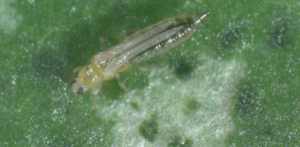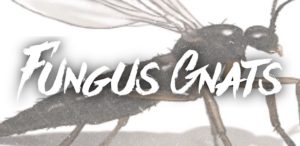Yes, even indoor gardens get invaded sometimes.
Indoor hydroponic gardens may have fewer pest problems than outdoor soil gardens, but that doesn’t mean they’re immune. Warm temperatures, humidity, and steady light make the perfect home for a few tiny freeloaders.
Here are the top 5 culprits you’re most likely to battle in a hydroponic setup—and how to catch them early.
Fungus Gnats
There are few things more annoying than gnats hovering in your face—but in hydroponics, the real danger is below the surface. It’s not the adult gnats doing the damage, but their larvae.
What to Look For:
- Small black flies buzzing around the grow medium or base of plants
- • Slimy, browning roots or wilting plants
Find out how to identify/rid your hydroponic garden of fungus gnats!
The Problem:
Adult fungus gnats lay hundreds of eggs in moist organic matter. Once hatched, the larvae feed on your plant roots—causing stunted growth, root rot, and even plant death in young plants.
🔍 Tip: Fungus gnats are attracted to decaying matter and algae. Keep your garden tidy and avoid overwatering your grow medium.
Aphids
Tiny and deceptively cute (at a glance), aphids are sap-sucking machines that quickly swarm your plants.
What to Look For:
- Sticky residue (called honeydew) on leaves
- Curled, yellowing, or misshapen leaves
- • Clusters of small insects on stems and undersides of leaves

Find out how to identify/rid your hydroponic garden of aphids!
The Problem:
Aphids suck nutrients from plant tissue, weakening growth. Their sugary excretions can attract mold and ants—some of which “farm” aphids to protect their sweet supply.
🐞 Tip: Ladybugs love aphids. Consider using them for organic pest control if you’re growing in a closed or controlled environment.
Spider Mites
These guys aren’t true spiders, but they spin webs and multiply at alarming speeds.
What to Look For:
- Fine webbing on leaves and stems
- Speckled, yellowing leaves
- Mites (red, white, or brown) under leaves
Find out how to identify/rid your hydroponic garden of spider mites!
The Problem:
Spider mites suck the chlorophyll right out of your plant cells, leading to necrotic spots and leaf drop. A single female can lay hundreds of eggs, and under warm conditions, eggs hatch in just 3 days.
🌿 Tip: Increase air circulation and reduce temps below 75°F to slow spider mite reproduction.
Whiteflies
Think of them as moth-looking vampires. They’re tiny, fluttery, and hungry.
What to Look For:
- Small white insects flying up when you disturb plants
- Sticky residue or black mold on leaves
- Wilting despite good water/nutrient supply

Find out how to identify/rid your hydroponic garden of whiteflies!
The Problem:
Whiteflies feed on plant sap and leave behind honeydew. They’re also virus carriers, making them one of the most dangerous indoor pests if left unchecked.
🔄 Tip: Use yellow sticky traps to catch adult whiteflies and monitor populations early.
Thrips
Thrips are sneaky, fast-moving pests that love to hide under leaves. And yes, they can fly and jump.
What to Look For:
- Silvery or bronze streaks on leaves
- White or pale spotting and stunted growth
- Thrips darting when disturbed (they’re quick!)

Find out how to identify/rid your hydroponic garden of thrips!
The Problem:
Female thrips inject eggs into leaf tissue, making them harder to eliminate completely. Their scraping feeding method damages cells and opens plants up to secondary infections.
🔍 Tip: Gently shake plants over a white sheet of paper to see if any thrips drop or scurry across it.
In Conclusion: Stay Vigilant, Stay Clean
Even in a squeaky-clean indoor hydroponic setup, pests can hitch a ride on tools, clothes, or even new plants. The best defense is a clean grow area, regular plant checks, and fast action at the first sign of trouble.
🚨 Prevention Tip Box:
- Clean up dead plant matter regularly
- Avoid overwatering your grow medium
- Quarantine new plants
- Use sticky traps for monitoring
- Maintain good airflow and humidity control
With a little observation and a few proactive moves, you’ll outsmart the bugs and keep your indoor garden thriving.










